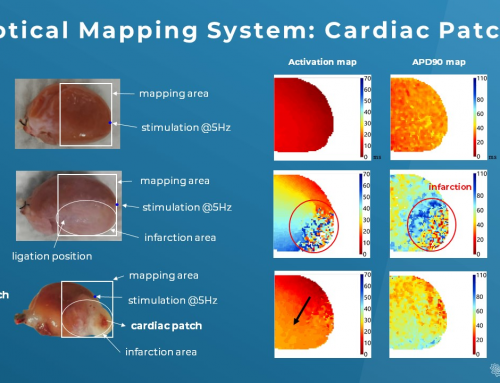by Dr Jay Lu
In this blog post, we have a pleasure to sit down to chat with Professor Chi Keung Lam about his journey in cardiovascular research and the goal of the Lam lab.
Dr. Lam is an Assistant Professor in the Department of Biological Science at University of Delaware. The Lam lab uses multiple platforms from human induced pluripotent stem cell (iPSC) to in vivo rodent models to identify disease mechanisms in both cardiac physiology and pathophysiology, and ultimately develop targeted therapeutics to improve clinical outcome.
Why did you choose the path of cardiovascular physiology? What’s interesting to you?
I like to see cells in motion. When I got to my graduate school, I was fascinated by those beating cardiomyocytes. Through assessing their contraction, you can detect interesting stuff. Another reason is that the current progress for cardiovascular research is simply not enough and I want to make a difference. I want to push the field. So these two reasons make me want to pursue this field.
It’s not that these cardiovascular diseases are affecting my family; in fact, it’s cancer that is affecting my family. When you compare that, my passion in cardiovascular research is a lot bigger than cancer research. That is why I feel like these cardiovascular diseases are what I want to spend my time on.
What is your research journey like?
I started off going for a PharmD degree at Purdue University and later decided not to pursue it. I decided that I wanted to go to graduate school. At Purdue, I worked on calcium channels in pancreas cells and at that time I was thinking where I wanted to go. Cincinnati happened to be a good option, because my PI at Purdue went there for a seminar and highly recommended it to me. I really take recommendations very seriously, especially from a mentor I trust. They have very strong cardiovascular research and I have an exact feeling this is what I want to work on: Cells in motion.
The other thing is that my PhD mentor, Prof. Litsa Kranias, is a very big figure in the cardiac field as well. So these two reasons got me thinking, well, I want to get into this area and also this area is not far away from what I am doing, studying calcium.
Back then, Prof. Kranias knocked out the phospholamban gene and this was the first time that people had knocked out a protein in an animal model and it actually helped the cardiac function. And this is also the place where I learned all the isolated heart techniques, including Langendorff and IonOptix. We were studying calcium and at the same time we were interested in arrhythmogenesis. We wanted to do in vivo studies, but you couldn’t really get much information from telemetry, so this was a bottleneck for us. We also wanted to measure calcium in an isolated heart, but we did not have the bandwidth to pull it off. Instead, we could only isolate mouse cardiomyocytes to closely measure the calcium fluctuations.
What is the focus of your lab at Delaware?
One of our major goals is to identify targeted therapy for both genetic or acquired cardiomyopathies. Calcium regulation dysfunction is definitely one direction worth looking into. We are also interested at stress signaling as well.
I think that maybe there are one or two targets that we can look for to reduce arrhythmogenesis without affecting cardiac ion channels. I think these types of studies will be tough without appropriate equipment to e.g, measure the electrical signal.
What motivated you to choose MappingLab?
Basically, when I identify some targets that have anti-arrhythmogenic property, I have to think about the next step, e.g., how can I test it? how can I prove it? It is really hard to do in vivo study with arrythmia because it is hard to induce arrhythmia in the mouse. You could measure action potential in cells, but it might not mean anything in the heart. That is our consideration of buying MappingLab’s electrical mapping system, because I think I need to have an instrument to measure electrical conduction abnormalities at the whole heart level. And the electrical mapping system is compatible with the Radnoti isolated heart system. Luckily, I got the funding for this purchase.
What factors were you considering when you were deciding the Electrical Mapping System?
The reason why I chose the electrical mapping system is that I want to test drugs and eventually want to test them in the whole heart level, not just on the cells. The second thing is that the drug or the target I’m dealing with is related to electrical signaling. I think the very logical next step is to look into how ablation of that gene target or a drug would change the electrical conduction, electrical velocity and etc, on the heart. It’s versatile as well. If I want to go for iPSC-cardiomyocyte electrical mapping, we just buy or switch the plate and use it in the same system. At this stage, versatility is one of key things I am looking for in an equipment.
Future plans and research…
It is tough to predict my future as I just get started. However, I really like the environment and the people at the University of Delaware, so I bet that I will enjoy some success and get tenured with multiple grants . I am determined to look for better targets and develop therapeutics. Hopefully we will be able to get some lead compounds or biologics for further development in 10 years.


